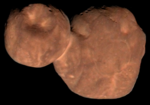GW 190814 was a gravitational wave (GW) signal observed by the LIGO and Virgo detectors on 14 August 2019 at 21:10:39 UTC,[2] and having a signal-to-noise ratio of 25 in the three-detector network.[1] The signal was associated with the astronomical super event S190814bv, located 790 million light years away, in location area 18.5 deg2[n 1][1][3][4] towards Cetus or Sculptor.[5][6][7][8][9][10] No optical counterpart was discovered despite an extensive search of the probability region.[11]
Discovery

In June 2020, astronomers reported details of a compact binary merging, in the "mass gap" of cosmic collisions, of a first-ever 2.50–2.67 M☉ "mystery object", either an extremely heavy neutron star (that was theorized not to exist) or a too-light black hole, with a 22.2–24.3 M☉ black hole, that was detected as the gravitational wave GW190814.[1][12]
"We don't know if this object is the heaviest known neutron star or the lightest known black hole, but either way it breaks a record."
— Vicky Kalogera, professor at Northwestern University.[13]
The mass of the lighter component is estimated to be 2.6 times the mass of the Sun (M☉ ≈ 1.9891×1030 kg), placing it in the aforementioned mass gap between neutron stars and black holes.[1][13][14][15][16][17]
Despite an intensive search, no optical counterpart to the gravitational wave was observed. The lack of emitted light could be consistent with either a situation in which a black hole entirely consumed a neutron star or the merger of two black holes.[14]
See also
Notes
- ^ The relatively large and distant area of the sky within which it is claimed to be possible to localize the source.
References
- ^ a b c d e f Abbott, R.; et al. (23 June 2020). "GW190814: Gravitational Waves from the Coalescence of a 23 Solar Mass Black Hole with a 2.6 Solar Mass Compact Object". The Astrophysical Journal Letters. 896 (2): L44. arXiv:2006.12611. Bibcode:2020ApJ...896L..44A. doi:10.3847/2041-8213/ab960f.
- ^ a b Staff (2020). "GW190814 Factsheet - Lowest mass ratio to date - Strongest evidence of higher order modes" (PDF). LIGO. Retrieved 26 June 2020.
- ^ Greco, G.; et al. (2020). "Handling gravitational-wave sky maps for EM-followUP observations - Second ASTERICS Virtual Observatory School" (PDF). Asterics2020.eu. Retrieved 27 June 2020.
- ^ Berry, Christopher (10 August 2018). "Sky-localization of Gravitational wave observations". CplBerry.com. Retrieved 27 June 2020.
- ^ Staff (14 June 2019). "GraceDB - Gravitational-Wave Candidate Event Database - Superevent Info". LIGO. Retrieved 27 June 2020.
- ^ Staff (23 June 2020). "Black hole or neutron star? - LIGO-Virgo scientists find mystery object in 'mass gap'". Pennsylvania State University. Retrieved 24 June 2020.
- ^ Starr, Michelle (16 August 2019). "Early Reports Indicate We May Have Detected a Black Hole And Neutron Star Collision". ScienceAlert.com. Retrieved 16 August 2019.
- ^ Mandelbum, Ryan F. (26 August 2019). "Mystery Deepens Around Newly Detected Ripples in Space-Time". Gizmodo. Retrieved 26 August 2019.
- ^ Starr, Michelle (11 February 2020). "First Papers on The Black Hole-Neutron Star Merger Are In. Here's What We Didn't See". ScienceAlert.com. Retrieved 11 February 2020.
- ^ Ackley, K.; et al. (5 February 2020). "Observational constraints on the optical and near-infrared emission from the neutron star-black hole binary merger S190814bv". arXiv:2002.01950v1 [astro-ph.SR].
- ^ Staff (25 June 2020). "GW190814 Sheds Light on Mass Gap between Neutron Stars and Black Holes". Sci-News.com. Retrieved 26 June 2020.
- ^ Staff (23 June 2020). "GW190814". LIGO Scientific Collaboration. Retrieved 24 June 2020.
- ^ a b Staff (24 June 2020). "Black hole or neutron star? - LIGO-Virgo scientists find mystery object in 'mass gap'". Pennsylvania State University. Retrieved 24 June 2020.
- ^ a b University of Birmingham (23 June 2020). "Gravitational wave scientists grapple with the cosmic mystery of GW190814". EurekAlert!. Retrieved 24 June 2020.
- ^ Overbye, Dennis (24 June 2020). "A Black Hole's Lunch Provides a Treat for Astronomers - Scientists have discovered the heaviest known neutron star, or maybe the lightest known black hole: "Either way it breaks a record."". The New York Times. Retrieved 24 June 2020.
- ^ Starr, Michelle (24 June 2020). "Astronomers Detect First-Ever Mystery Object in The 'Mass Gap' of Cosmic Collisions". ScienceAlert.com. Retrieved 24 June 2020.
- ^ Cho, Adrian (24 June 2020). "Gravitational waves reveal lightest black hole ever observed". Science. Retrieved 25 June 2020.
External links
- "Detections". LIGO.
- Video (2:25): GW190814 binary black hole merger – overview on YouTube (24 June 2020; Science Fellow)
- Video (1:32): GW190814 binary black hole merger (animation) on Vimeo (24 June 2020; LIGO Scientific Collaboration)
- Video (1:32): GW190814 binary black hole merger (animation) on YouTube (23 June 2020; Max Planck Institute for Gravitational Physics)
- Video (0:10): GW190814 gravitational wave from mysterious object on YouTube (23 June 2020; Gravitational-wave Open Science Center (GWOSC))
















You must be logged in to post a comment.